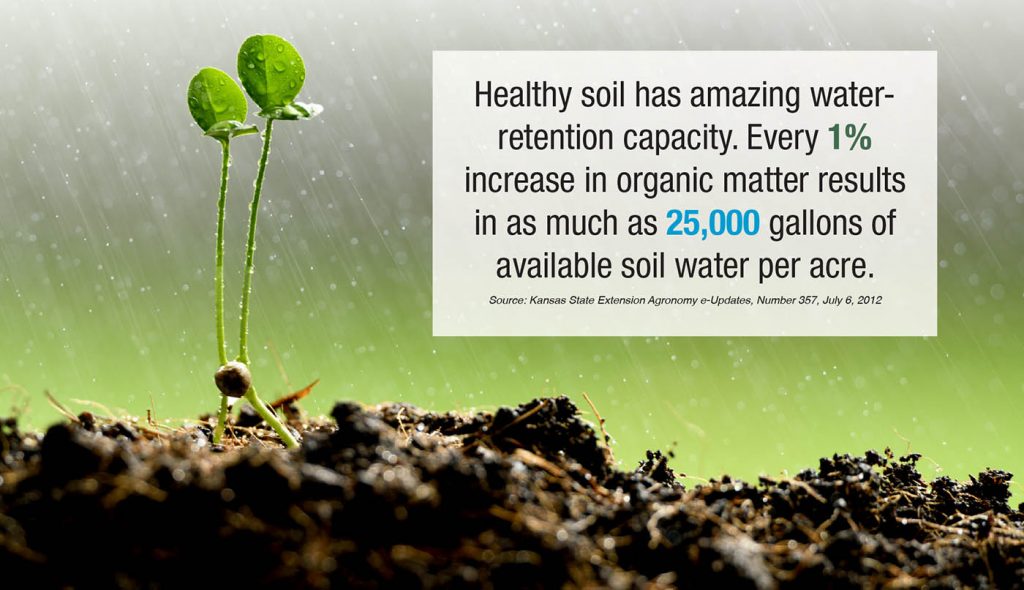
By Sarah Bostick
Regenerative agriculture is fast becoming a buzz phrase in America. You may have heard about it on the news, in feature films or in farmer forums online. You may have seen the words “regeneratively grown” on a box of mac and cheese, a tub of yogurt, a container of oatmeal or even a case of beer.
DEFINING THE TERM
But what is regenerative agriculture? There is not one single working definition of regenerative agriculture, but at its core is the idea that virtually all agricultural farmland in the world has been damaged over time and that growers can actively improve the health of the land.
Regenerative agriculture is best thought of as a collection of land management practices that restore soil health. The list of land management practices generally includes the use of diverse cover crops, managed grazing, the creation of on-farm fertility, no or minimal use of pesticides and synthetic fertilizers, and no or minimal tillage.
INSIDE THE SOIL
We often think of soil as simply soil, but soil is actually a very complex system. If you pick up a handful of healthy soil, approximately 45 percent of the volume is mineral (sand, clay or silt), 25 percent is water, 25 percent is air, and 5 percent is organic matter. Organic matter is a small part of most soil, but the services it provides to your farm are vast.
Organic matter is anything that is or once was alive. Organic matter is the part of soil that most effectively captures and holds nutrients, prevents erosion and lessens the impacts of both flooding and drought. Organic matter is what makes soil the most biologically diverse ecosystem on the planet. It is also the part of soil that captures and holds carbon.
It is this last bit — carbon capture and storage — that has caught the attention of people from every walk of life and recently put agriculture on the big screen.
In the book “Soil as World Heritage,” soil scientists estimate that since the start of agriculture, approximately 320 billion tons of soil carbon have been lost worldwide from clearing land for agriculture. That is equal to the weight of 107 billion standard-sized pickup trucks.
According to the book, most agricultural soils worldwide have lost 12 to 16 tons of carbon per acre. That’s equal to 25 to 75 percent of what existed before the land was first cleared.
Where does soil carbon go when it is released? It goes back into the atmosphere in the form of carbon dioxide.
Tillage releases carbon stored in the soil back into the atmosphere. By minimizing tillage and focusing on building organic matter, soil can store the huge quantities of carbon that plants pull out of the atmosphere through photosynthesis.
The higher the organic matter level in the soil, the more carbon it is storing. According to Paul Hawken’s book “Drawdown,” for every 1 percent increase in soil organic matter, about 8.5 tons per acre of carbon are stored.
Most of the attention that regenerative agriculture is receiving boils down to the idea that agriculture can be a powerful force in removing the top greenhouse gas (carbon dioxide) from the atmosphere.
Farmers are clearly seeing the benefits. An estimated 108 million acres of farmland worldwide currently practice regenerative agriculture, according to “Drawdown.”
If you are interested in learning about regenerative agriculture directly from farmers who practice it, here are a couple videos to get you started:
- Dave Brant: www.youtube.com/watch?v=ZOuJ2bUGcTc
- Gabe Brown: www.youtube.com/watch?v=ExXwGkJ1oGI
REGENERATIVE ORGANIC CERTIFIED
As of fall 2020, there is a new certification: Regenerative Organic Certified (ROC; regenorganic.org). The certification is overseen by a nonprofit organization called the Regenerative Organic Alliance. Rather than creating a different set of rules and regulations, ROC certification is based primarily on ensuring that a farm has a collection of other certifications.
The three pillars of ROC are soil health, animal welfare and farmworker fairness. The soil health pillar requires that farmers be U.S. Department of Agriculture Certified Organic. The animal welfare and farmworker fairness pillars are proven through certifications such as Animal Welfare Approved and Food Justice Certified.
CONCLUSION
Regenerative agriculture doesn’t have a clear-cut definition, but it does have a growing following amongst both farmers and consumers. Regenerative agriculture is not an all-or-nothing concept. As you learn more about it, you might start with giving just one of the ideas a try. Regenerative agriculture is a process of learning what works on your unique piece of land.
Sarah Bostick is a University of Florida Institute of Food and Agricultural Sciences sustainable agriculture Extension agent in Sarasota.









